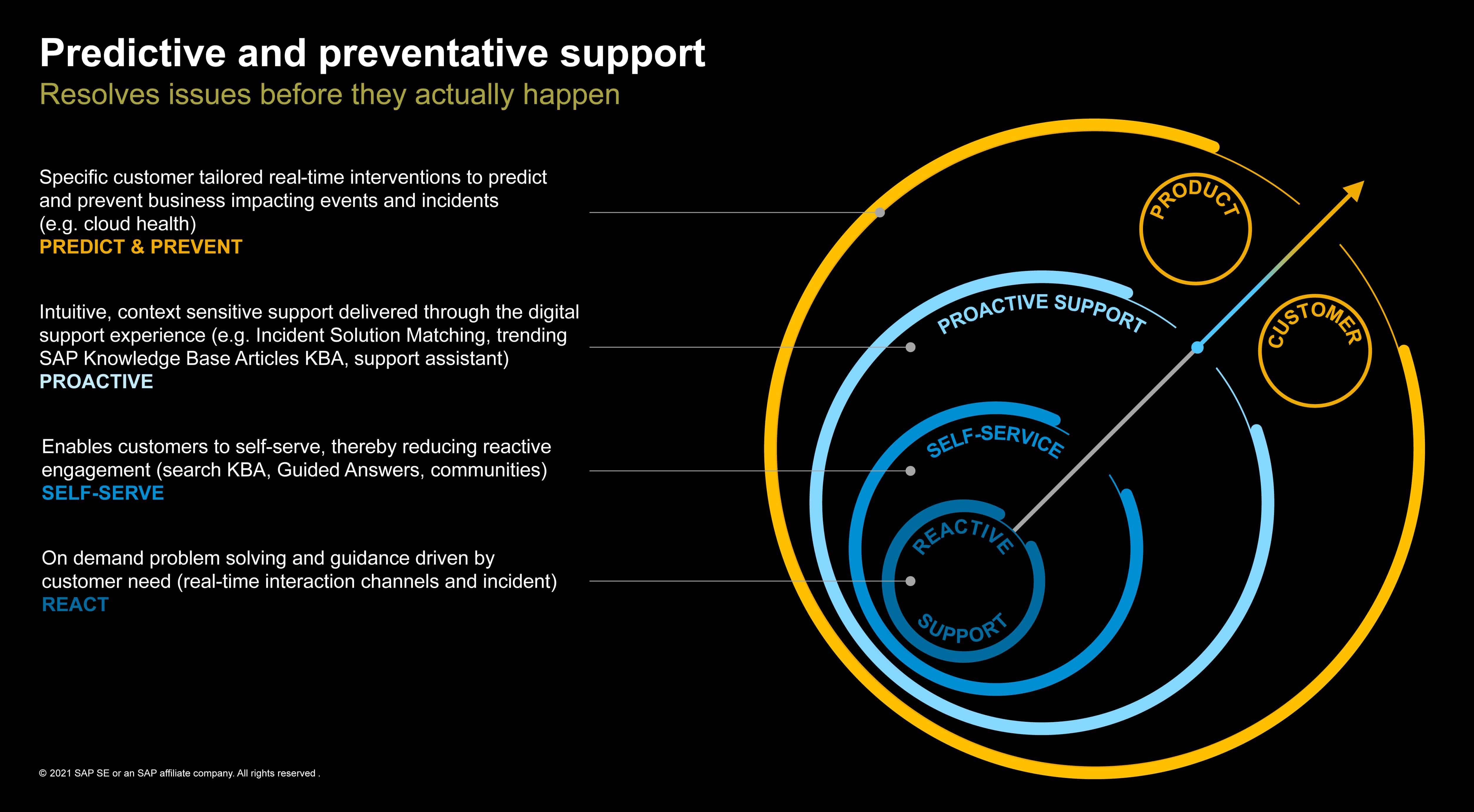Imagine a world in which technology predicts problems before a customer encounters them. Does that sound too good to be true? It’s not; in fact, it has been the holy grail of the support industry for many years. It’s called predictive support, and its capabilities go far beyond what has been developing in computer hardware for many years using sensors to signal warnings before problems become apparent.
SAP is an early pioneer in producing tangible examples of what this predictive and cutting-edge technology will do in the future.
The Evolution of Support
Thirty years ago, the industry was focused on reactive support, in which customers had a problem, they logged a ticket, and we got back to them with a solution. From there, new functionalities were developed such as peer communities, which encouraged customer-to-customer collaboration and mutual support, and real-time support channels that allowed for synchronous interactions with support. Eventually, self-service was introduced to empower customers with the tools, knowledge, and issue documentation to find their own solutions for common problems.
More recently, automation has come into the picture. Technologies like artificial intelligence (AI) and machine learning have become more pervasive and support organizations started automating repetitive and administrative tasks. And today, the Product Support organization at SAP is starting to help customers get the answers they need faster than ever before. For example, in 2018, we introduced Incident Solution Matching, a service that helps customers get relevant answers to technical questions faster by using machine learning to identify possible solutions when customers are typing their described problem.

New Technology, New Solutions
Today, the support industry is being severely disrupted due to the pandemic. This is in addition to the already significant shift caused by software moving toward the cloud. The landscape is changing, and enterprise software technology is getting more sophisticated, with a greater number of integration points.
With the aggressive move to the cloud, support has become a significant element of retention and renewal. Whereas in the past, it was quite difficult for a customer to change vendors, regardless of their support experience, for cloud customers, this is no longer as difficult. The barriers to switch providers are much lower in the cloud space.
However, the nature of support services is not only changing due to new technology. The capabilities are changing just as quickly thanks to the development of new technologies that take advantage of the sector’s most valuable resource: data. Support organizations sit on a vast wealth of data, and, as is often said these days, data is the new oil.
Our opportunity is to determine how to make this data work for the customer. Manually, this would be impossible: with millions of tickets handled each year, the sheer volume of data would be overwhelming. But machine learning and AI have given us the ability to go through millions of records, quickly and efficiently, identifying trends and patterns that we can use to quickly identify current problems and, even better, to predict problems before they arise.
Possible Hurdles Remain
The benefits of predictive support are clear: saved time, money, and effort for both the vendor and the customer — a true win-win. However, that doesn’t mean that all will be smooth sailing as the evolution of predictive support continues. Two possible hurdles that are on the horizon currently include customer notification and the amount of system access a customer can provide. The more we know about a customer’s system, and if we are allowed to have access to it, the better our predictions will be.
To begin with, who gets notified when and about what will be a major consideration moving forward, as we need to be extremely prescriptive with our alerts and notifications. For example, when it comes to large customers, a vendor could have 200 contacts using product support, from end users to database administrators and up to the CIO. It would be quite a problem if the CIO of a major corporation was alerted every time a potential event did not occur, whether or not it would have become a problem for their system. A vendor must be certain that when an alert goes out, the customer’s system is going to encounter that problem.
And the data that support services draws on to create cutting-edge predictive support is limited if, due to the nature of a customer’s work, they must keep large parts of their system private. Highly secure environments, such as financial services or intelligence sector customers, will require even more innovative solutions in order to reap the benefits of predictive support while maintaining a secure system.
However, given the disruption we have seen in the last year and the huge surge in cloud services that followed, support services and customers will continue to work together to overcome these and other hurdles as the demand for predictive support grows. Already, the gains that have been made in this area are incredible considering how nascent machine learning technology is.
The Future Is Bright for Predictive Support
Until recently, the work of support services was always predicated on a customer needing help with software. We became better and better at providing this help quickly and efficiently, but all of our work was triggered by a customer having a problem.
In the coming years, that will no longer be the case. In software, we can’t predict everything before it happens. But we can increasingly learn from the past to predict the future and transform the support experience into one in which support prevents an issue from becoming a business-impacting event. We will be transforming data into future insights.
Throughout the evolution described here, the goal for support services has always been to increase value while decreasing effort. Eventually, the industry will get to a point where no customer effort is required whatsoever: a system will be continuously serviced before breakdowns occur, seamlessly performing without the need for customer intervention.
And if that sounds too good to be true, just remember that it was not so long ago that predictive support would have sounded impossible. As Clarke’s Third Law reminds us, “Any sufficiently advanced technology is indistinguishable from magic.”
Mohammed Ajouz is senior vice president and global head of Product Support at SAP.



